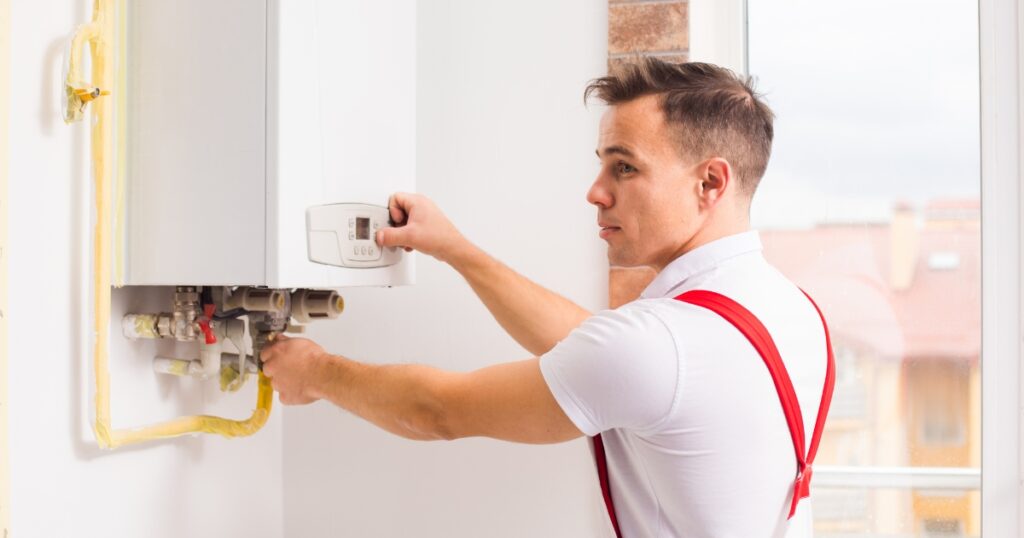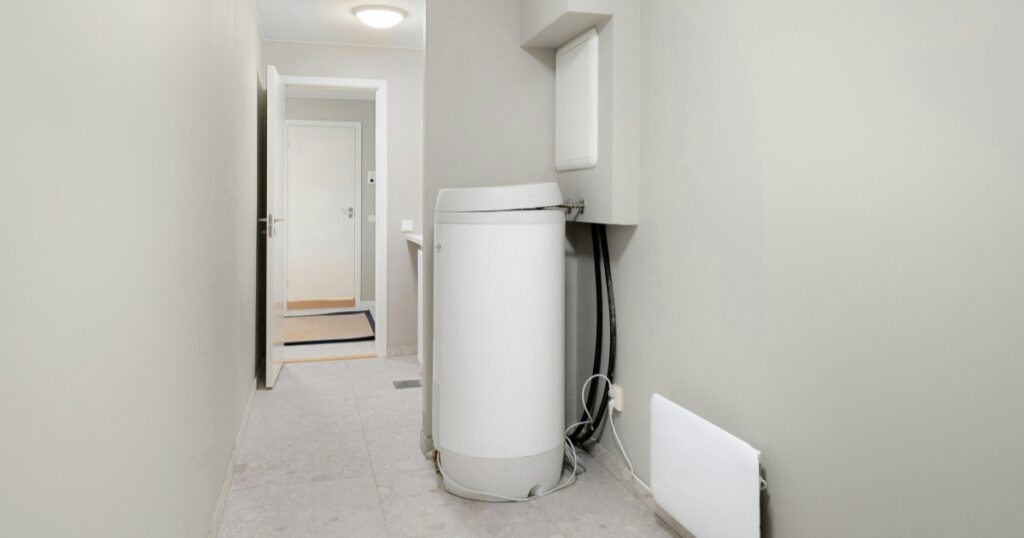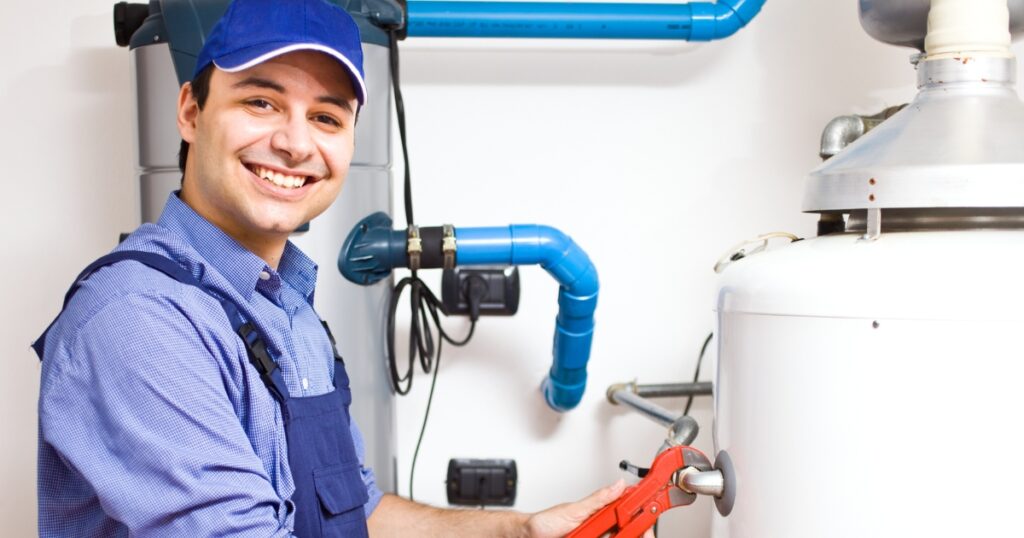Reckon you’re sorted for a cosy shower, but the tankless water heater’s thrown a wobbly – giving you the cold shoulder instead of heat. Fair dinkum, it happens to the best of us.
I’ve gone on a bit of a dig about to work out what’s throwing your hot water for six. Our guide’s chockers with tips that are easy as pie and will have your system back in tip-top shape before you can say ‘Bob’s your uncle’.
Keen as mustard to ditch the chilly showers? Stick around – we’re here to lend a hand!
Key Takeaways
- Troubleshooting a tankless water heater involves checking the power supply, ensuring proper water flow, and addressing blockages to maintain optimal performance.
- Common issues such as no hot water or excessive heat can be resolved by checking for power supply interruptions and monitoring system demands.
- Regular maintenance, including descaling the system and addressing leaks promptly, is crucial for preventing long-term damage to your tankless water heater.
- Monitoring factors like ventilation, water pressure, and temperature fluctuations helps ensure a reliable hot water supply without unexpected surprises.
Common Issues with Tankless Hot Water Heater Systems
- No Hot Water
- Water that is Too Hot
- Low Water Pressure
- Noisy Unit
- Discoloured Water and an Unpleasant Odour
- Burner Fails to Ignite
- Temperature Fluctuations
- Leaks

No Hot Water
Finding yourselves with no hot water can be a real hassle, but don’t worry; we’ve got some troubleshooting tips. First things first, check if the power supply to your tankless system is connected and functioning properly.
Sometimes it’s as simple as a tripped circuit breaker or a blown fuse. Gas water heaters might have pilot light issues—make sure yours is lit.
Ensure you’re not overloading the system by running multiple appliances at once that require hot water. If reducing demand doesn’t help, there could be a blockage restricting water flow or mineral buildup in the unit.
It’s worth inspecting for any obstructions and considering descaling if necessary to restore proper performance without calling in professionals just yet. Keep an eye on these areas regularly to avoid surprises with cold showers!
Water that is Too Hot
If your tankless water heater is producing water that is too hot, it may be due to overloading the system. This can happen when there’s a high demand for hot water, causing the heater to work overtime and heat the water excessively.
To address this issue, try reducing the demand for the water heater by using hot water more efficiently or installing a larger unit if needed.
In addition, mineral buildup within the system can lead to overheating issues. Regular descaling of the unit can help prevent this problem and ensure that your tankless water heater operates at an optimal temperature.
Monitoring and adjusting the temperature settings on your unit can also help regulate the water temperature and prevent it from becoming too hot.
Low Water Pressure
If you’re experiencing low water pressure in your tankless water heater system, it can be frustrating and disruptive to daily activities. Minerals and sediments may accumulate within the unit over time, causing a reduction in water flow.
To address this issue, consider descaling the system regularly to remove buildup and ensure proper water flow. Additionally, check for any blockages in the pipes or filters that could be impeding water pressure.
Regular maintenance is crucial to preventing these issues from affecting your hot water supply.
Adjusting the temperature settings can also help improve the performance of your tankless water heater system by regulating the flow of hot water and maintaining consistent pressure throughout use.
Noisy Unit
If your tankless water heater is making loud noises during operation, it could be a sign of mineral buildup inside the unit. This can impede the flow of water and cause a rattling or banging sound.
In some cases, the noise could also indicate an issue with the gas combustion process, such as incomplete burning of fuel. These issues may require professional inspection and maintenance to ensure safe and efficient operation.
Moving on to “Discolored Water and Unpleasant Odour”, let’s address common solutions for these concerns.
Discoloured Water and an Unpleasant Odour
When dealing with hot water heater tankless systems, homeowners may encounter discoloured water and unpleasant odours. This can be a sign of mineral buildup or corrosion within the system, leading to changes in water quality and odour.
It is essential to address this issue promptly as it can affect the overall functionality and safety of the hot water heater.
If you notice discoloured water or an unpleasant smell from your tankless water heater, it’s important to conduct thorough maintenance. Descale the system regularly to prevent mineral buildup and ensure that there are no blockages affecting the water quality.
Burner Fails to Ignite
If you notice that your tankless water heater’s burner fails to ignite, it could be due to several reasons. First, check the gas supply and ensure there are no interruptions or issues with the gas line.
Next, inspect the igniter for any damage or wear and tear, as a faulty or worn-out igniter can prevent the burner from lighting properly. Additionally, cleaning the burner assembly and ensuring proper ventilation around the unit can also help resolve ignition problems.
If these troubleshooting steps do not solve the issue, it may be necessary to contact a professional for further assistance in diagnosing and repairing the problem.
Regular maintenance is essential for ensuring that all components of your tankless water heater function efficiently. Checking and addressing any issues promptly can help prevent more significant problems down the line.
Temperature Fluctuations
Temperature fluctuations in tankless water heaters can be caused by a variety of factors, including mineral buildup, power supply issues, or improper sizing. When the system struggles to maintain a consistent temperature, it may lead to discomfort and inconvenience.
Monitoring and adjusting the settings for optimal performance is essential for preventing sudden changes in water temperature.
Regular maintenance like descaling and professional inspections are necessary to address issues with temperature control effectively. It’s important that homeowners take proactive measures to ensure that their tankless water heater operates smoothly, providing reliable hot water without unexpected fluctuations.
Preventative steps such as maintaining proper ventilation and monitoring water pressure also contribute to consistent temperature regulation within the system.
Leaks
If you’ve encountered temperature fluctuations in your tankless water heater, it’s essential to also keep an eye out for leaks. Even minor leaks can lead to significant issues with the system over time.
Leaks can occur due to loose connections, worn-out seals, or internal damage to the unit. It’s important to regularly inspect your tankless water heater for any signs of leakage and promptly address them to prevent further damage.
Regular maintenance is crucial in preventing leaks – checking for any signs of water accumulation around the unit and addressing them immediately can help maintain the integrity of your tankless water heater.

Solutions for Troubleshooting Tankless Water Heater Problems
Check for power supply and ensure that the unit is receiving electricity to function properly.
Check for power supply
To troubleshoot issues with your tankless water heater, start by checking the power supply.
Here’s a step-by-step guide to ensure the power supply is not causing any problems:
- Verify that the power switch for the water heater is turned on.
- Check if there is a tripped circuit breaker in the electrical panel that powers the water heater.
- Ensure that the water heater is receiving power by testing the outlet with another device or using a multimeter.
- If the water heater is connected to a GFCI outlet, make sure it has not been tripped.
- Inspect all wiring and connections to ensure they are secure and free from damage.
- If you suspect an electrical issue, contact a qualified electrician to inspect and repair any faults in the system.
Ensure proper water flow
To ensure proper water flow in your tankless water heater, it is important to:
- Regularly clean the inlet filter to prevent debris from obstructing the flow of water into the system.
- Check for any kinks or blockages in the water supply line leading to the heater and clear them as needed.
- Verify that the water pressure entering the unit meets the manufacturer’s recommended specifications, as inadequate pressure can impact performance.
- Inspect for any leaks or drips in the plumbing around the water heater that could impede water flow and address them promptly.
- Consider installing a dedicated hot water line to ensure a consistent and unobstructed supply of water to your tankless system.
Address any blockages
To ensure the proper functioning of your tankless water heater system, it is important to address any blockages that may be hindering the water flow. Here are some steps to address blockages:
- Inspect the inlet filter for any debris or mineral buildup that could be obstructing the water flow.
- Use a soft brush or cloth to gently clean the inlet filter and remove any accumulated dirt or sediment.
- Check the pipes and fittings for any obstructions or build-up that could be impeding water flow through the system.
- If there are noticeable blockages, carefully remove and clean the affected components before reassembling the system.
Descale the system
To ensure optimal performance of your tankless water heater system, it’s important to address any blockages that may be affecting its efficiency. Another crucial step is to describe the system regularly. Descaling involves removing mineral deposits that can build up over time and affect the heater’s performance. Here are some steps for descaling your tankless water heater:
- Turn off the power and water supply to the unit.
- Open the purge port valves to drain any remaining water from the system.
- Use a solution of white vinegar and water or a commercial descaling agent to flush out any mineral buildup inside the unit.
- Let the descaling solution sit in the system for the recommended amount of time as per manufacturer instructions.
- After allowing sufficient time, thoroughly rinse out the system with clean water to remove any remaining descaling solution and mineral deposits.
- Close the purge port valves and restore the power and water supply to the unit.
Reset the system
To ensure optimal performance of your tankless water heater, follow these steps to reset the system:
- Turn off the power supply to the water heater by switching off the circuit breaker or unplugging it from the power source.
- Wait for at least 5 minutes to allow the system to completely power down.
- After 5 minutes, turn the power supply back on and restart the water heater.
- Once the system is reset, monitor its operation to ensure that any previous issues have been resolved.
- If problems persist after resetting, it may be necessary to consult a professional for further diagnosis and repair.
- Regularly resetting your tankless water heater can help troubleshoot minor technical glitches and maintain its efficiency.
When to Call a Professional
If you are facing complex issues or have safety concerns with your tankless water heater, it is best to call a professional for assistance. Avoid attempting to fix potentially dangerous problems on your own.
Complex issues
Complex issues with tankless water heater systems might require professional assistance. Safety concerns such as gas leaks or electrical malfunctions should only be addressed by experienced technicians.
When troubleshooting problems involving the system’s internal components, it is essential to seek professional help to avoid causing further damage. Regular maintenance and inspection can help prevent severe issues from arising, ensuring the long-term functionality and safety of your hot water heater.
If a tankless water heater unit experiences persistent complex issues or safety concerns, homeowners should immediately consult a qualified technician to address and resolve these problems promptly and efficiently.
Safety concerns
Regular maintenance is essential for ensuring the safety of your tankless water heater. It is crucial to monitor the system for any unusual smells, discolouration, or leaks, as these may indicate potential safety hazards.
Additionally, addressing issues promptly and seeking professional help when needed can help prevent major safety concerns with your hot water system.
Improper sizing of the unit and mineral buildup can lead to a lack of sufficient hot water and cause safety issues. Ensuring proper ventilation and monitoring water pressure are also important aspects of maintaining a safe tankless water heater system.
Preventative Maintenance for Tankless Water Heaters
Regular descaling is essential to prevent buildup and maintain the efficiency of the system. Proper ventilation is also important to ensure safety and optimal performance. Monitoring water pressure can help identify any issues early on while checking for leaks regularly can prevent larger problems from occurring.
Regular descaling
Descaling your tankless water heater on a regular basis is essential for maintaining its efficiency and prolonging its lifespan. Over time, mineral deposits can build up inside the system, leading to reduced water flow and compromised heating performance.
By descaling the unit at recommended intervals, you can prevent these issues and ensure that your hot water heater continues to operate at its best.
Scaling occurs as a result of hard water, which contains high levels of minerals such as calcium and magnesium. These minerals can accumulate within the internal components of the tankless water heater, impeding heat transfer and causing potential damage.
Proper ventilation
To prevent overheating and ensure the efficient operation of your tankless water heater, it is crucial to maintain proper ventilation. Inadequate ventilation can lead to a buildup of exhaust gases, causing potential safety hazards for you and your family.
By keeping the area around the water heater clear and ensuring that vents are unobstructed, you can help maintain optimal airflow and prevent any issues related to improper ventilation.
When it comes to addressing proper ventilation for your tankless water heater, it’s important to regularly inspect venting systems and make sure they are free from any blockages or debris.
Good ventilation not only ensures safe operation but also contributes to the overall longevity of your tankless water heater system.
Monitor water pressure
Monitor the water pressure in your tankless water heater regularly to ensure it remains at optimal levels. Fluctuations or drops in water pressure can indicate potential issues with the system that may need attention.
Check for any leaks or blockages that could be affecting the water flow and pressure, as these can impact the performance of your hot water heater.
Maintaining consistent and adequate water pressure is crucial for ensuring that your tankless water heater operates efficiently and effectively, providing you with a reliable supply of hot water whenever needed.
Check for leaks
To troubleshoot tankless water heater issues, we recommend regularly checking for leaks around the unit. Leaks can lead to water damage and affect the performance of the system. By inspecting for leaks, you can spot any potential problems early and prevent further damage to your home and water heater.
Leaks are often caused by loose connections or damaged components within the unit. If you notice any signs of leakage, it’s essential to address them promptly to avoid costly repairs and ensure the efficient operation of your tankless water heater system.
Deal with Common Issues Smoothly
In conclusion, troubleshooting common issues with tankless water heater systems requires checking for power supply and ensuring proper water flow. Regular maintenance and professional inspection can help prevent and address these problems.
It’s important to address any blockages and describe the system as part of regular maintenance routines. Also, keeping an eye on ventilation, water pressure, and leaks can help maintain the efficiency of your tankless water heater.






